Invented by Ran Roland Kohen, SKYX Platforms Corp
One of the key advantages of modular smart quick connect devices is their simple installation process. Traditional electrical fixtures often require professional assistance for installation, which can be time-consuming and costly. However, with modular smart quick connect devices, homeowners can easily install and connect these devices themselves, eliminating the need for professional help. This not only saves time and money but also empowers homeowners to take control of their electrical systems.
Another significant advantage of these devices is their modular nature. They can be easily customized and expanded based on individual needs and preferences. For example, homeowners can add or remove modules to accommodate different electrical fixtures, such as lights, switches, outlets, or even appliances. This flexibility allows for a highly personalized and adaptable electrical system that can be easily modified as needs change over time.
Energy efficiency is another crucial aspect of modular smart quick connect devices. These devices often come equipped with advanced energy-saving features, such as motion sensors, timers, and dimmers. These features enable homeowners to optimize energy consumption by automatically turning off lights when not in use or adjusting brightness levels to suit their needs. By reducing unnecessary energy consumption, these devices not only help homeowners save on their electricity bills but also contribute to a more sustainable and eco-friendly lifestyle.
Furthermore, modular smart quick connect devices offer remote control capabilities, allowing homeowners to control their electrical fixtures from anywhere using their smartphones or other smart devices. This feature provides convenience and peace of mind, as homeowners can easily turn lights on or off, adjust dimming levels, or even monitor energy usage while away from home. Additionally, some devices offer voice control compatibility with virtual assistants like Amazon Alexa or Google Assistant, further enhancing the convenience and accessibility of these devices.
The market for modular smart quick connect devices is witnessing significant growth due to the increasing demand for smart home solutions. According to a report by MarketsandMarkets, the global smart home market is projected to reach $135.3 billion by 2025, with a compound annual growth rate of 11.6%. This growth is driven by factors such as rising consumer awareness about energy efficiency, technological advancements, and the growing adoption of Internet of Things (IoT) devices.
In conclusion, the market for modular smart quick connect devices for electrical fixtures is expanding rapidly, driven by the need for convenience, customization, energy efficiency, and remote control capabilities. These devices offer homeowners a range of benefits, including easy installation, customization options, energy savings, and remote control convenience. As the demand for smart home solutions continues to rise, the market for modular smart quick connect devices is expected to grow further, revolutionizing the way we interact with our electrical systems.
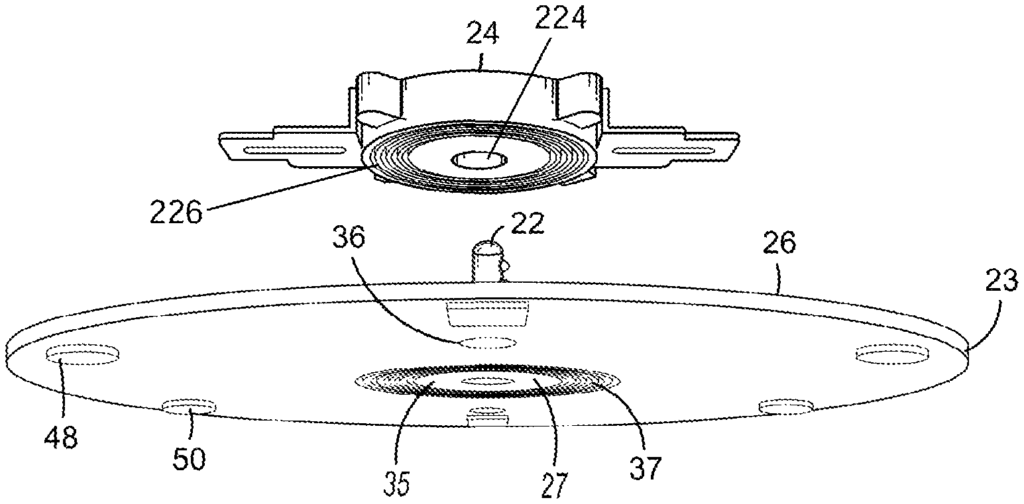
The SKYX Platforms Corp invention works as follows
An electrical fixture includes a plug or a socket having concentric terminal rings. The plug has a spindle which is receivable in a central channel within the socket, forming a latch. The plug or socket can be attached to an electrical hub with peripheral connectors. The peripheral electrical connectors allow modules to be connected to the hub. Each module contains electrical components that have one or more features. Modules can be selected for specific features such as transmitting or receiving information, or sensing an environment condition, like a security camera. The hub may include a central board that is electrically linked to peripherally mounted modules. The hub is also connected to the electrical wiring of edifice in which the fixture is mounted.
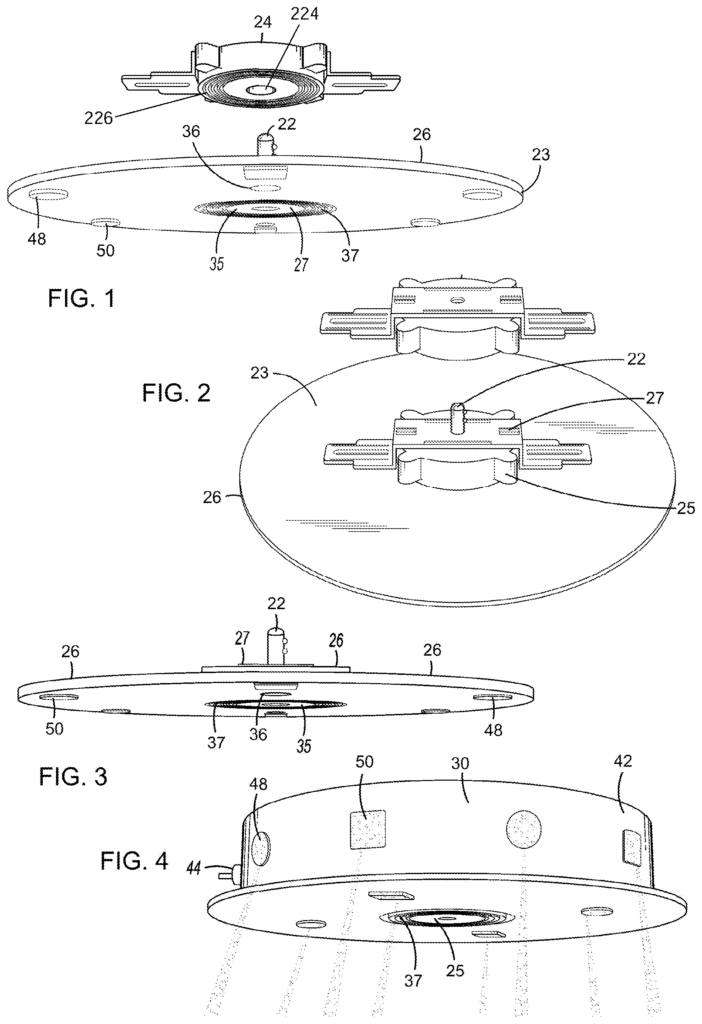
Background for Modular smart quick connect device for electrical fixtures
There are several commercially available smart-home environments. Systems can be comprised of one or more network-connected devices and sensors. The smart-home devices may be able to communicate and integrate within a smart-home environment. The smart-home devices may also communicate with cloud-based smart-home control and/or data-processing systems in order to distribute control functionality, to access higher-capacity and more reliable computational facilities, and to integrate a particular smart home into a larger, multi-home or geographical smart-home-device-based aggregation.
The installation of electrical appliances and fixtures such as fans and lighting fixtures on ceilings or walls usually requires the help of an electrician. They also require a range of tools and specialized equipment. Even if an experienced installer is performing the installation or removal, it can still be a lengthy and dangerous process. The installer is required to make mechanical connections in addition to hand-wiring electrical connections between the fixture, electrical power supply wiring and the fixture itself.
The device includes a plug that is rigidly attached to the fixture, and can be inserted into the socket. It has one or two male connectors, which are connected to the fixture, and which mate with the contact terminals in the socket. This creates a circuit connecting the electrical fixture to the power wiring.
The device may include variations such as a central electronic board located within the hub. Each of a number of sensor modules can be electrically connected using a wired connection when connected to the peripheral edge of the Hub; or a hub that is circular and the sensor module includes a circuit with an arcuate form corresponding to the radius of the Hub.
The invention also includes “other variations thereof” where at least one module of a sensor wirelessly transmits a sensed state; at least another sensor wirelessly receives signal; signal is a control signal for the device or an electrical fixture associated with it; and/or command signal is the result of the sensed state.
The device can be further modified to include a sensor module that includes a transmitting and receiving sensor. This sensor detects environmental conditions such as temperature, humidity and smoke. It also includes a motion/presence sensor, a glass breakage sensor, an emergency light, a sensor module with a housing, a housing with an access hole, and/or a sensor module with a housing and an opening.
The device is a “device for connecting an electric fixture with electrical power supply wires, and mounting the fixture to a support. It comprises a socket with a socket body that has at least a single internal cavity; a number of electrically conductive concentric-ring-shaped contacts terminals located within the cavity to establish an electrical connection with the socket and electrical power wiring. A plug, which is fixed to the electrical fixation and can be inserted into the socket. This plug contains a number of concentric-ring-shaped contacts terminals, and are a plug, and is ring-shaped concentric-shaped contact ring-shaped concentric-shaped concentric-shaped contact ring-shaped concentric-shaped contact ring-shaped ring-shaped ring-shaped ring-shaped ring-shaped-shaped-shaped-shaped-shaped-shaped-shaped-shaped-shaped-shaped-shaped-shaped-shaped-shaped-shaped-s-shaped-shaped-shaped-shaped-shaped-shaped mate with the contact terminals in the cavity, to mate with the ring-s- – – – – – – – – – – – – – – –
In a variation, the socket defines a mating plan, and the plug is mateable with it by inserting the connector into the socket at any angle radial lying on the mating plan.
As needed, embodiments have been disclosed; however, the disclosed embodiments should be understood as examples, and that systems and methods described herein can be embodied under various forms. The specific structural and functionality details disclosed herein should not be interpreted as restrictive, but rather as a basis of the claims, and as an example basis to teach one skilled in art how to employ the subject matter in any appropriate detailed structure or function. The terms and phrases employed herein do not limit the subject matter, but are intended to describe the concepts in a way that is understandable.
The terms?a? or?an?, as used herein, are defined as one or more than one. As used in this document, the terms?a? As used in this document, the term plurality is defined as more than two. As used herein the term another is defined as a second and more. The term?including? The terms?including? As used herein, the words “comprising” and “having” are defined as open language (i.e., inclusive). The term “coupled” is used here. As used in this document, the term ‘coupled,’ is defined as “connected,” “Connected” is defined as “not necessarily directly or mechanically, but not necessarily.
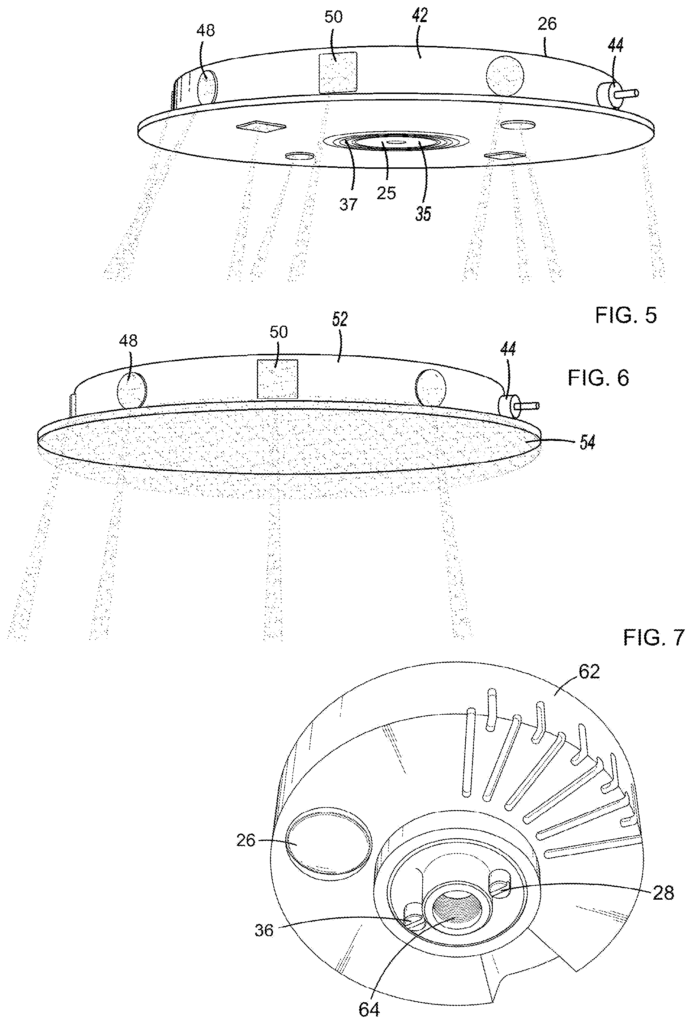
The disclosure in this document relates to prior work of the inventor, as described in the Related Patents and Applications Section, whose contents are incorporated herein in their entirety.
A ?quick connect device? A plug and matching socket are used to install electrical fixtures. The device’s plug and socket serve to establish electrical connections between an electrical fixture, electrical supply wiring and a base or surface, such as a wall or ceiling. The term “fixture” is used in this document. The term ‘fixture’ or ‘electrical fixture” is used here to refer to any appliance, such as a lighting fixture, ceiling fan, television camera, security device or other device that requires a mechanical connection in order to support or suspend it. Any fixture or appliance, such as a ceiling fan, lighting fixture, television camera or security device, which is powered via electrical wiring and requires a mechanical connection in order to be supported or suspended. The socket is attached to the wall, ceiling, or floor on which the fixture will be mounted. “The structure, function and operation of the mating plug and socket has already been described in the patents and applications incorporated herein.
A ?smart quick connect device? The disclosure generally defines a connector as having additional functionality beyond the ability to provide a connection. A smart quick-connect device can include a sensor unit that wirelessly communicates a sensed state. A smart quick connect device may include a sensor unit that wirelessly receives a signal. The signal can be used to control the smart connect device or the electrical fixture. The command signal may be independent or a result from the sensed condition.
For example, referring to the reference PCT/US2016/032170 published as the? ‘170 publication? (‘170 publication? The ‘170 publication, as well as other references incorporated therein, provide a detailed description of the plugs 20 and 22, including their structure and functions. This is not discussed in detail in this document. In the publication ‘170, one or several sensors or other electronic or electrical devices 48 or 50 (hereinafter “sensors”) are associated with either plug 22 or socket 24. Plug 22 or socket 24, respectively, have been connected to the sensors. These sensors can be replaced within an assembly 600 that includes modular sensor modules 626. This allows for a variable configuration.
The plug 22 and matching socket 24 of device 20 serve to establish an electrical connection between a fixture and the electrical supply wiring and to mechanically support the fixture, which is typically a wall or ceiling surface. The term “fixture” is used in this document. The term ‘fixture’ or ‘electrical fixture” is used here to refer to any appliance, such as a lighting fixture, ceiling fan, television camera, security device or other device that requires a mechanical connection in order to support or suspend it. Any fixture or appliance, such as a ceiling fan, lighting fixture, television camera or security device, which is powered via electrical wiring and requires a mechanical connection in order to be supported or suspended. The plug 22 is permanently attached to the electrical fixture (not shown), whereas the socket 24 can be fixed to the wall, ceiling, or floor on which the fixture will be mounted or an electrical junction box. The socket 24 is used as a base because electrical conductors that carry dangerous electrical signals are recessed, and should not be touched by people. When only low voltage/low-power signals are used, however, the location of plug and socket may be arbitrarily selected or reversed.
Referring, generally to FIGS. 1-3, a ?conventional? socket 24 of a ?conventional? quick connect device for installing electrical fixtures ordinarily receives a ?conventional? plug. Instead and in accordance with the disclosure, a combination device 23 is configured and dimensioned to mate with socket 24. Combination device 23 includes a spindle assembly 22 as found in a ?conventional? plug for releasably mechanically connecting combination device 23 to socket 24 with spindle assembly 22 insertable into a central channel 224 of socket 24. Combination device 23 also includes a body 25 formed out of non-conductive material and has on a first side 27 concentric, male connector rings (see element 225 as shown in FIG. 16, analogous to those found in a ?conventional? plug) integrally molded into the body 25, with sufficient radial spacing therebetween to electrically insulate them from each other. The diameters and spacing of the male connector rings are such that they are alignable with and receivable within corresponding female recesses forming a plurality of electrically conductive concentric ring-shaped contact terminals 226 in the socket 24. As detailed in the patent publications incorporated by reference, this alignment electrically connects the combination device 23 to the socket 24.
One or more pushbuttons 36 that are mechanically connected to spindle assemblies 22 provide a way of activating spindle assemblies 22 with either a finger, or a tool.
Combination unit 23, which receives power from socket 24 is electrically connected to a sensor unit 26. The sensing unit 26 has one or more sensors (48, 50). Sensors 48 act as receiver sensors for receiving signals. Below are some examples of signals that may be received. Sensors 50 act as transmitter sensors for transmitting signals. Below are non-limiting examples for the types of signals that may be transmitted. Sensors 48 and 50 can be placed on any surface of the sensing unit 26 depending on their application.
Depending on the sensors 48 and 50, sensing module 26 can be used to operate device 23 using a remote control, such as RF, WiFi or Bluetooth. Sensors 48, 50 can also be used to determine environmental conditions, such as smoke and CO detectors, temperature sensors, humidity sensors, or motion/presence sensors. The sensing unit 26 is a part of an integrated security system. Sensors 48, 50 can be a camera with or without motion detection, a glass breakage detector (with or w/o motion activation), a motion/presence sensor, and/or battery-backed emergency lighting.
The circuit boards were designed to be integrated with and attached to the combination device 23, and they each have a different amount of circuitry. Patent publications describe exemplary circuits and concepts that are incorporated in general by reference without distinction as to which board contains which function.
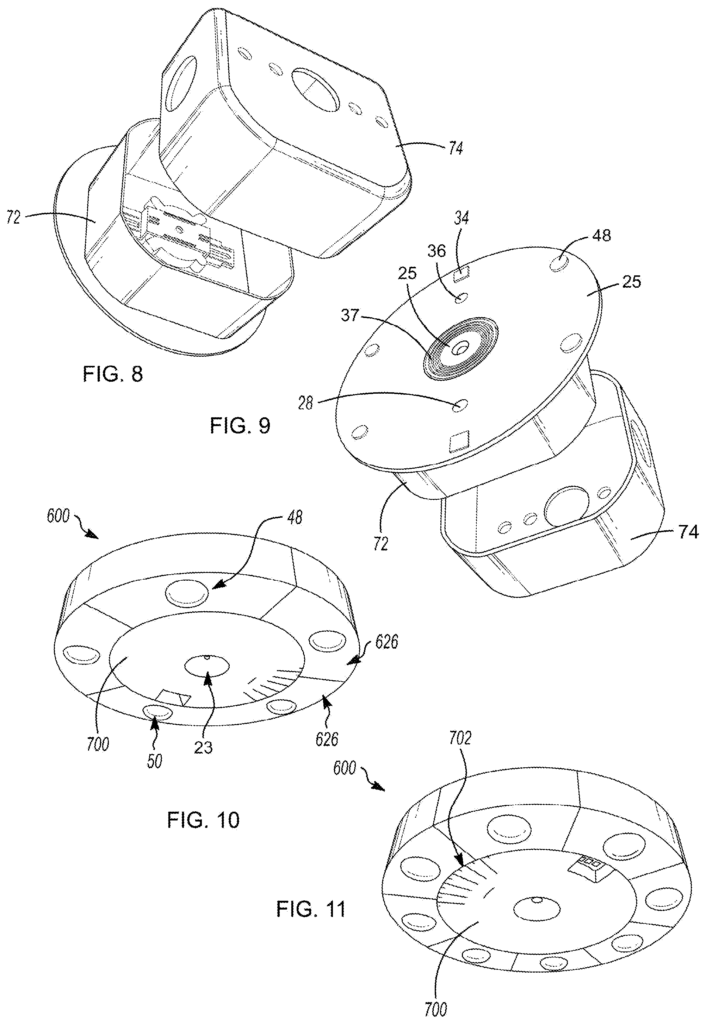
The second side of the body 25 has concentric, ring-shaped female recesses. These slots are electrically connected to the male connector ring on the first 25 side of the body and are configured to mately receive male connector ring on an electrical fixture plug (not shown).
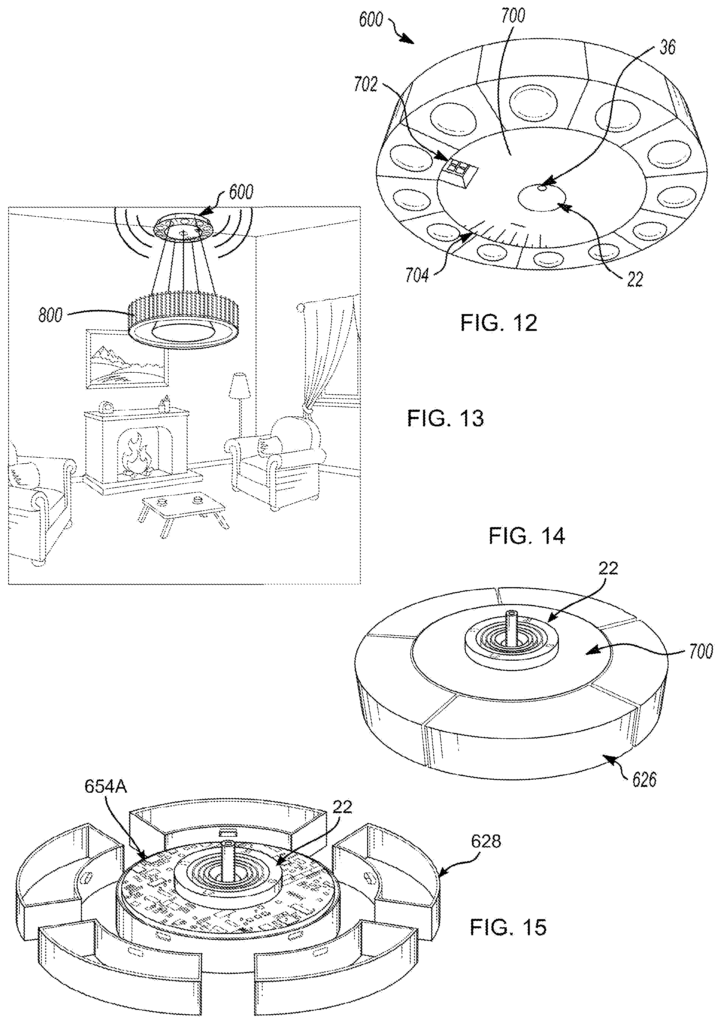
Click here to view the patent on Google Patents.
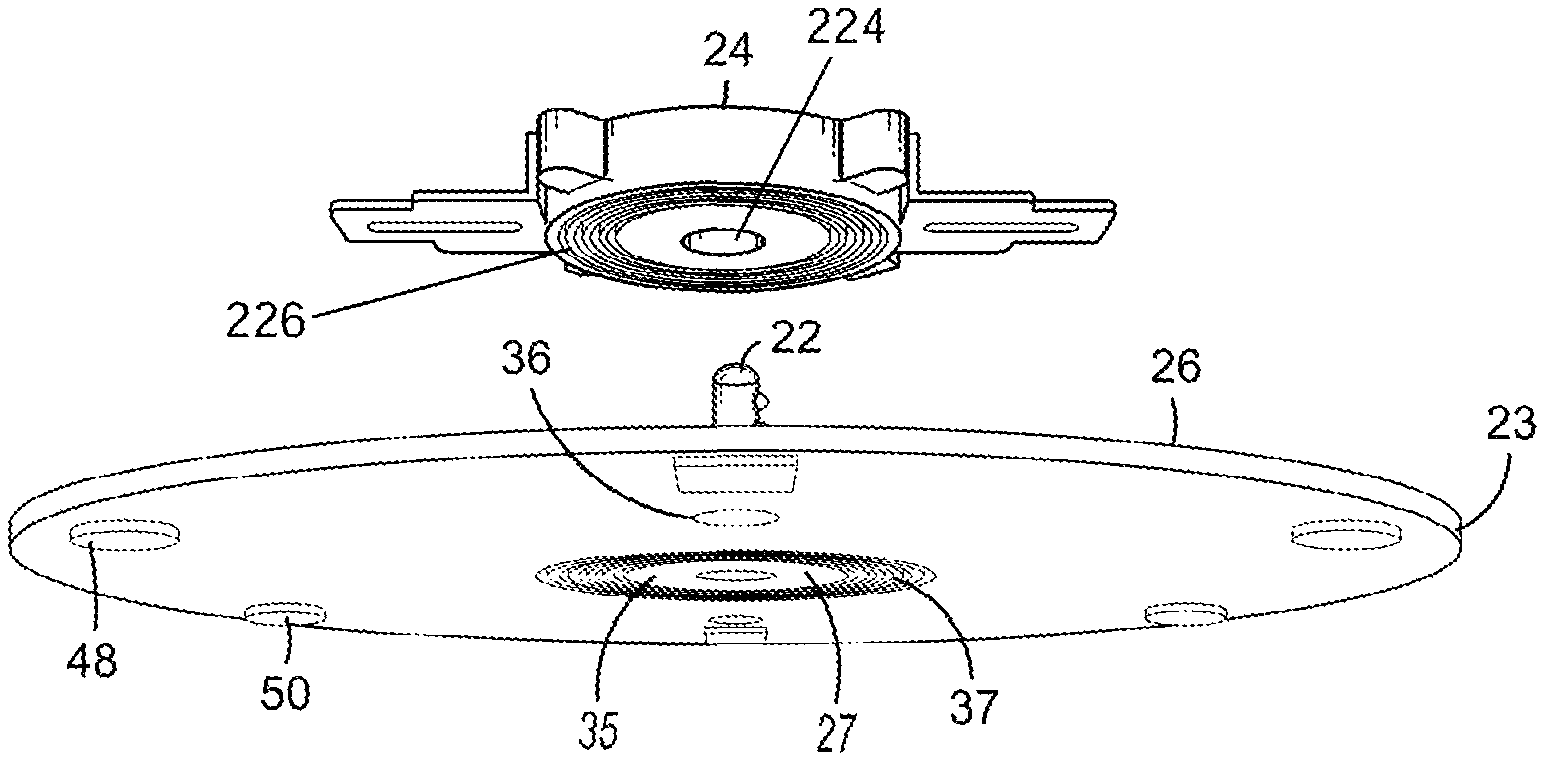
Leave a Reply